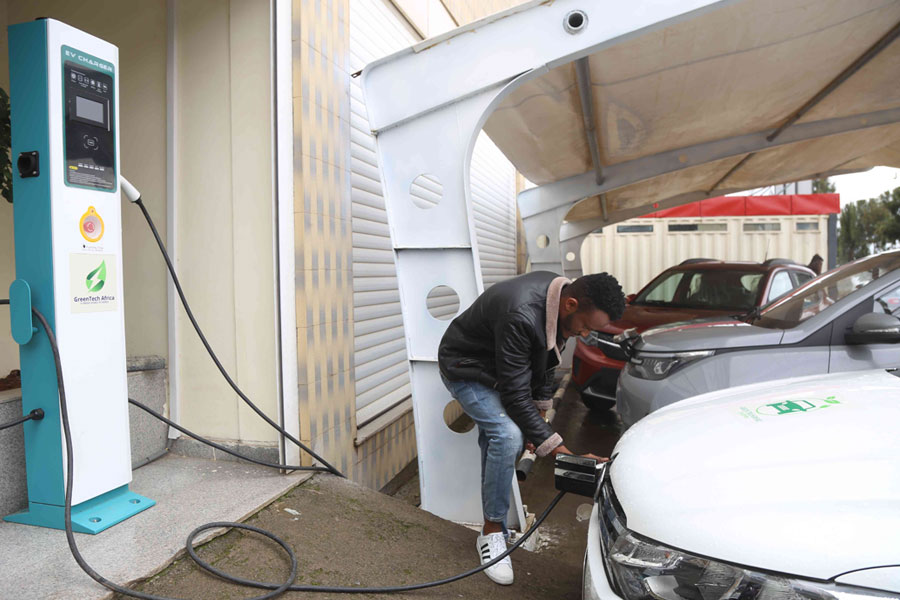
On the morning of August 21, 2019, Mekdes Tuffa, 40, a housewife and a mother of one, stood in a long queue at the Ethiopian Electric Utility Addis Abeba District, the seventh customer service branch located at Arat Kilo.
Mekdes, who lives at Ferensay Legasion, has not been able to pay her electric utility bill, despite coming to the utility for a second day.
“Paying the electric utility bill used to take two hours, but now I couldn’t pay it in two days," Mekdes, said.
She is not the only one who faces this problem. Many other residents have experienced difficulty in paying their electric utility bills.
The four cashiers at the utility were trying to provide service to more than 800 customers.
Yeshiharg Mulatu, a housewife who is in her late 50s and lives at Menelik, was also at the payment office for the second time attempting to pay her electric bill.
“Previously, we paid at the Lehulu branch around Sidest Kilo, and it was never this crowded,” Yeshiharg said.
“I was here at 5:00am but couldn’t get the service,” she adds, "and I have a lot of tasks at home."
For the past seven years, utility payments for electricity, telecom and water had been managed by Lehulu, a one-stop-shop for various utility payments operated by Kifiya Financial Technologies, a public-private partnership (PPP).
Kifya, an IT company established in 2010 with over 1,000 employees, launched Lehulu in 2013 in a partnership with Ethio telecom, Ethiopian Electric Utility, Addis Abeba Water & Sewerage Authority and the then Ministry of Communications & Information Technology for the specific purpose of facilitating utility bill payments.
Customers are waiting for their turn to pay the electric bill at the Ethiopian Electric Utility Addis Abeba District, the seventh customer service branch located in Arat Kilo.
However, beginning this month, Lehulu Payment System handed over the assignment to the respective government offices after its contract with the government expired.
Following that, the offices under the City Administration have been negotiating with the Commercial Bank of Ethiopia (CBE) to handle these payments. CBE launched an electronic platform and entered into service agreements with Ethiopian Electric Utility, Addis Abeba Water & Sewage and Addis Abeba Traffic Management Agency to process payments from customers.
A few months ago, the City's Traffic Management Agency and Addis Abeba Water & Sewerage Authority provided window service payment, debt service payment, mobile banking and internet banking as payment options to their customers.
Commercial Bank of Ethiopia and Ethiopian Electric Utility, the state-owned electric power distribution agency, had signed a memorandum of understanding (MoU) on January 21, 2019. However, the service has not started yet, creating inconvenience for the customers.
Gelan Telila, north Addis Abeba electric utility service director, admits that the problem exists.
“After the contract with Lehulu was ended, there is an overflow of customers who come to pay their bills at the branch,” Gelan said. "Besides this shortage of workforce, connection problems are an additional factor."
The EEU has hired 150 new cashiers throughout the utility and extended working hours to 8:00pm this month to overcome this problem.
"We believe that this situation will be solved in the coming month when we cluster customers in groups according to their registration number and when CBE starts its operation," he adds.
Equipment and facility shortages have also caused another problem in the service delay at the Utility's office.
"We have five cashiers, but only four are working because of a shortage of equipment such as computers," said Yibeltal Aniley, one of the cashiers at Ethiopian Electric Utility North Addis Abeba Region Service.
“Most customers come all at once, and the shortage of manpower limits us from operating at full capacity,” said Girma Hailu, technical head at the branch. "Starting from next week, we plan to serve our customers according to their registration clusters."
At the second customer service branch of the North Addis Abeba Electric Utility, Fortunewas able to observe around 300 customers standing in long queues to pay their electric utility bills.
As a permanent solution, CBE is in the final stages of handling the service, according to Yeabsera Kebede, communications manager of the Bank, which has 22 million customers and earned 17.9 billion Br in gross profit during the recently ended fiscal year.
“Currently, we're working on integrating the systems and registering customers,” said Yeabsera. “When we begin operations, customers can pay their bill at any of the 300 branches of the Bank in the city."
Melaku Taye, corporate communications director at EEU, which earned 7.1 billion Br in profit during the recently ended fiscal year, also believes that the problem is temporary and hopes that the problem will be solved next month.
However, Nega Wubie, a lecturer at Addis Abeba University's Public Administration Department, believes that these kinds of problems happen because of spontaneous decisions and lack of research.
“Before shifting services from Lehulu to EEU they had to complete their preparation,” Nega said. “The government should trust private banks for such services, and there is no basic reason to make CBE the only service provider."
To avoid overcrowding and modernise its system, EEU has already registered its clients' data on its new Enterprise Resource Planning database, which enables EEU to collect, store and manage customer information, according to Melaku.
“Besides this, EEU has also arranged 33 paying centres in the four corners of the city for low power electricity users,” he adds.
Ethiopian Electric Utility has 50,000 high power users, around three million low power or domestic users, and approximately 500,000 prepaid card users.
For high and medium electric power users, they must use Commercial Bank of Ethiopia to make their payments, but low power users can also use the Bank for settling their bills if they already have savings account at the Bank. New users must sign an agreement with the Bank.
So far, 4,000 high, medium and low power electricity users are registered to pay their electric bills through the CBE platform.
In Ethiopia, the demand for electric power increases by 13pc each year, and the electricity coverage of the nation has reached 58pc.
The country currently generates 4,300MW of power, of which 90pc is produced from hydropower, while 8pc is generated from wind and 2pc from thermal sources.
Ethiopia has a potential of generating over 1.4 million megawatts from hydroelectric, solar, geothermal and wind sources, according to internal studies.
Currently, 58,000 households are waiting to get electric service in the country.
Atlaw Alemu (PhD), assistant professor at Addis Abeba University's College of Business & Economics, believes that inappropriate service, besides discomfort and dissatisfaction of the customers, will affect the revenue of the government.
“Customers would have been more effective if they had spent their time doing their jobs rather than spending their productive time in queues like this,” said Atlaw.
Atlaw says during transitional periods, these kinds of problems can happen, but they should have been prepared, and in the future, they will have to take this as a lesson.
PUBLISHED ON
Aug 24,2019 [ VOL
20 , NO
1008]

Fortune News | Jul 25,2020

Viewpoints | Aug 12,2023

Fortune News | Feb 25,2023

Radar | Dec 15,2024

Viewpoints | Feb 27,2021

Radar | Aug 20,2022

Fortune News | Jul 13,2024

My Opinion | Oct 09,2021

Fortune News | Sep 28,2019

Sunday with Eden | Oct 19,2019

Dec 22 , 2024 . By TIZITA SHEWAFERAW
Charged with transforming colossal state-owned enterprises into modern and competitiv...

Aug 18 , 2024 . By AKSAH ITALO
Although predictable Yonas Zerihun's job in the ride-hailing service is not immune to...

Jul 28 , 2024 . By TIZITA SHEWAFERAW
Unhabitual, perhaps too many, Samuel Gebreyohannes, 38, used to occasionally enjoy a couple of beers at breakfast. However, he recently swit...

Jul 13 , 2024 . By AKSAH ITALO
Investors who rely on tractors, trucks, and field vehicles for commuting, transporting commodities, and f...

Jun 28 , 2025
Meseret Damtie, the assertive auditor general, has never been shy about naming names...

Jun 21 , 2025
A well-worn adage says, “Budget is not destiny, but it is direction.” Examining t...

Jun 14 , 2025
Yet again, the Horn of Africa is bracing for trouble. A region already frayed by wars...

Jun 7 , 2025
Few promises shine brighter in Addis Abeba than the pledge of a roof for every family...